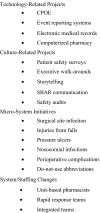Struggling to invent high-reliability organizations in health care settings: Insights from the field
- PMID: 16898982
- PMCID: PMC1955344
- DOI: 10.1111/j.1475-6773.2006.00568.x
Struggling to invent high-reliability organizations in health care settings: Insights from the field
Abstract
The Mission of the Agency for Healthcare Research and Quality (AHRQ) has been to support and conduct health services research and to disseminate those research findings. Recently the Agency has changed its mission to: "Improving the quality, safety, efficiency and effectiveness of health care for all Americans." For agency personnel working with the topic of patient safety, that change has created a need to develop greater awareness of the current patient safety initiatives underway at leading health care systems in order to determine where AHRQ might best play a role in helping these systems more rapidly adopt new practices to improve patient safety. In order to make that determination, AHRQ conducted a customer needs assessment of leaders in selected health care systems, asking them questions about their current implementation initiatives and their perceived needs for continued implementation of patient safety initiatives. Although not designed or conducted as a research study, the hour-long interviews produced rich insights into the implementation efforts of patient safety initiatives. The senior leaders interviewed in each of the health care systems, described implementing patient safety initiatives on multiple fronts-in some systems as many as 15 initiatives were underway. As the number of initiatives attests, there was no lack of knowledge about what patient safety practices should be implemented (CPOE, rapid response teams, reduction in surgical site infections) rather the major struggle these health care systems faced was the "how to" of implementation. Most initiatives were only newly begun, so these leaders were not yet confident about what they had learned from these efforts or whether they could be sustained over time. These health care systems drew many of the ideas for initiatives from outside of health care, for example, the nuclear power industry or aviation. The executives expressed concern about a number of issues including: how patient safety initiatives should be sequenced, the lack of benchmarking data to measure their systems against and the pressing need for IT standardization. The insights from this customer needs assessment revealed a wealth of implementation knowledge in the field and has led AHRQ to create an opportunity for leading edge health care systems to learn from each other via learning networks.
Similar articles
-
AHRQ issues critical analysis of patient safety practices.Qual Lett Healthc Lead. 2001 Aug;13(8):8-12, 1. Qual Lett Healthc Lead. 2001. PMID: 11530622
-
Implementing a national strategy for patient safety: lessons from the National Health Service in England.Qual Saf Health Care. 2005 Apr;14(2):135-9. doi: 10.1136/qshc.2004.011882. Qual Saf Health Care. 2005. PMID: 15805460 Free PMC article.
-
Current pulse: can a production system reduce medical errors in health care?Qual Manag Health Care. 2007 Jul-Sep;16(3):226-38. doi: 10.1097/01.QMH.0000281059.30355.76. Qual Manag Health Care. 2007. PMID: 17627218
-
Improving safety for children with cardiac disease.Cardiol Young. 2007 Sep;17 Suppl 2:127-32. doi: 10.1017/S1047951107001230. Cardiol Young. 2007. PMID: 18039406 Review.
-
Fundamentals of a patient safety program.Pediatr Radiol. 2008 Nov;38 Suppl 4:S685-9. doi: 10.1007/s00247-008-0882-1. Epub 2008 Sep 23. Pediatr Radiol. 2008. PMID: 18810418 Review.
Cited by
-
Assessment of High Reliability Organizations Model in Farabi Eye Hospital, Tehran, Iran.Iran J Public Health. 2018 Jan;47(1):77-85. Iran J Public Health. 2018. PMID: 29318121 Free PMC article.
-
Nonoperating room anaesthesia: safety, monitoring, cognitive aids and severe acute respiratory syndrome coronavirus 2.Curr Opin Anaesthesiol. 2020 Aug;33(4):554-560. doi: 10.1097/ACO.0000000000000895. Curr Opin Anaesthesiol. 2020. PMID: 32628402 Free PMC article. Review.
-
High-reliability health care: getting there from here.Milbank Q. 2013 Sep;91(3):459-90. doi: 10.1111/1468-0009.12023. Milbank Q. 2013. PMID: 24028696 Free PMC article.
-
Medication incident reporting in residential aged care facilities: limitations and risks to residents' safety.BMC Geriatr. 2012 Nov 2;12:67. doi: 10.1186/1471-2318-12-67. BMC Geriatr. 2012. PMID: 23122411 Free PMC article.
-
Encouraging openness in health care: Policy and practice implications of a mixed-methods study in the English National Health Service.J Health Serv Res Policy. 2023 Jan;28(1):14-24. doi: 10.1177/13558196221109053. Epub 2022 Jun 22. J Health Serv Res Policy. 2023. PMID: 35732062 Free PMC article.
References
-
- Bessant B, Kaplinsky R, Morris M. Developing Capability through Learning Networks. Journal of Technology Management and Sustainable Development. 2003;2(1):19–38.
-
- Dixon NM. Common Knowledge: How Companies Thrive by Sharing What They Know. Boston: Harvard Business School Press; 2000.
-
- Institute of Medicine. Crossing the Quality Chasm: A New Health System for the 21st Century. Washington, DC: National Academy Press; 2001. - PubMed
-
- Kohn LT, Corrigan JM, Donaldson MS, editors. To Err Is Human: Building a Safer Health System. Washington, DC: National Academy Press; 1999. - PubMed
-
- Mills P, Weeks W, Surott-Kimberely BC. A Multi-Hospital Safety Improvement Effort and the Dissemination of New Knowledge. Joint Commission Journal on Quality and Safety. 2003;29(3):124–33. - PubMed
Publication types
MeSH terms
LinkOut - more resources
Full Text Sources
Medical
Research Materials


